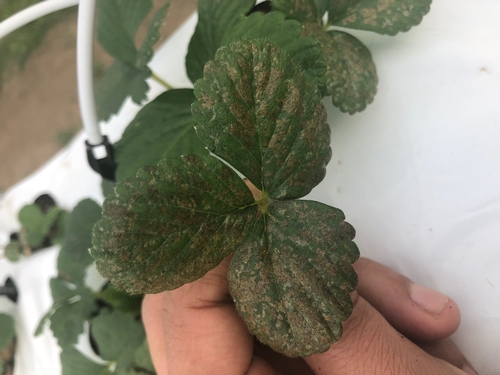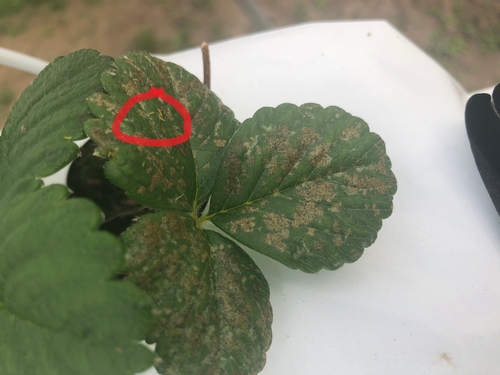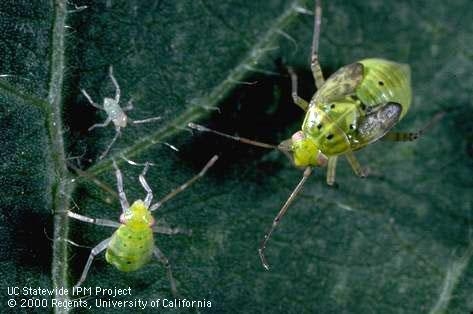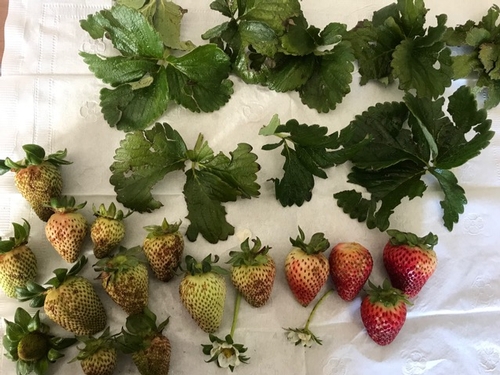
- Author: Mark Bolda
This piece was originally posted in late November, but see updated postscript concerning the identity of the pest at the bottom:
Already giving away the punchline in the title, but I was approached yesterday by a grower experiencing an unusual problem on his strawberries. All of this has been handled remotely, so on first glance I see drying out spots of various sizes and shapes on the leaves with dark spots in the middle of many of them (Picture 1 below). Problem tends to occur and be more severe on mature leaves. Pretty inconclusive, but the gut response would be a fungal disease with the dark spots being fruiting bodies of some sort.
However, on receipt of more pictures (Picture 2 below) this morning, lo and behold I was able to discern the culprit as thrips. Note the similar sized and shaped yellow objects gathered around one of the spots in this picture.
Haven't seen this problem before, but the situation in which it is happening is also unusual. Strawberry grown in substrate under a tunnel without weed mat and consequent weed growth underneath.
Directing the grower and his support staff to our recently updated UC IPM Guidelines for strawberry for counsel on how to manage this problem:
https://www2.ipm.ucanr.edu/agriculture/strawberry/
Updated postscript: A reader in Uruguay noted that he had this sort of damage on strawberries there caused not by our typical Western flowers thrips, but a species of Caliothrips. This for sure was intriguing, so I had a sample mailed to me by the grower and my colleague Steven Koike at Trical graciously agreed to do the identification.
Just got word back and based on the sample submitted to Steve, the thrips occurring in this field are Western flowers thrips. My take on the unusual nature of the damage is that the weeds below the growing area and the higher temperatures of the tunnels must have something to do with this.
Anyway, real group effort here to get the right answer and a workable solution to the grower. Thanks everybody!!


- Author: Mark Bolda
- Author: Shimat Joseph
Former UCCE Entomology Advisor Shimat Joseph and I just had the linked paper below published in Crop Protection.
Excellent overview of the lygus problem in California strawberries and evaluation of a combination of bug-vac use and the insecticide sulfoxaflor (not registered yet, but useful for this study since it actually works) for management of this pest.
A few points out of the paper to take back to the farm:
1- The use of the bug-vac alone was not sufficient to reduce lygus populations to below that of the untreated check.
2- Treatments using the insecticide sulfoxaflor alone and in combination with the bug-vac reduced the numbers of lygus and the number of cat faced fruit.
3- Neither the bug-vac or sulfoxaflor had any effect on predaceous heteropterans and spiders compared to the untreated check.
The implication out of this work and paper is that the use of an effective insecticide will continue to be the best tactic for control of lygus and mitigation of its damage in strawberries.
Link is here, it will be active until the beginning of October:
https://authors.elsevier.com/a/1XWqVxPFYekQG

- Author: Mark Bolda
Below is a picture of what hail can do to strawberry. A friend forwarded me these pictures of what a freak hailstorm a few days ago over his field left behind. Shredded leaves, pitted and bruised fruit right down to pretty undeveloped green ones, even on the flower. This storm represents a huge setback for his farm.
I'd have a hard time getting up and facing the day after a loss like this, but nevertheless you growers do it as a matter of course.
Bless you for the work you do and the food you grow for us in spite of the curveballs Mother Nature can throw at you.

- Author: Mark Bolda
As we creep towards strawberry planting season on the Central Coast, it is always good to review where we stand currently on nursery cold conditioning, and with this in mind, think about adjustments to the post harvest supplementary chill based on what sort of winter we might be expecting.
Those of you who know me understand my faith in hedging my bets and planning for contingencies. I favor decisions with a high probability of success and decent outcomes over swing for the fences with blow your socks off results but missing and failing most of the time. Short supplemental chill times with early planting dates to get the beat on the competition are not my thing since this strategy puts good plant vigor at risk, especially if this 2017-18 winter is warm.
Chill accumulation for this year looks good at the nurseries up at MacDoel. Using Lassen Canyon Nursery's chill accumulation chart (also appreciate the comps to previous years- very useful), shows that, after a warm start in September, hours have really ramped up and currently as of October 5 we are at 337 total hours according to my Utah model calculations (which subtracts chill during warm weather episodes, and discounts temperatures under freezing - look elsewhere on this blog for how I am doing this). That compares very well with previous years, and is in fact ahead of many of them.
Further, looking forward to what sort of winter we are to expect, let's go to the NOAA weather maps. Quite simply, for all of our strawberry production areas, it is as of now 40% probable that we get temperatures above normal this winter (being December, January and February). This is up from 33% a few weeks ago, so I am sensing a trend which seems to confirm where we are headed.
http://www.cpc.ncep.noaa.gov/products/predictions/long_range/lead03/off03_temp.gif
In conclusion, with solid field chill already in the can but a good probability of a warmer than normal winter in the offing, I would again this year favor just a little bit more supplemental chill than customary.
- Author: Mark Bolda
Attached is the latest iteration of the grower guidelines a number of us at UC Cooperative Extension have written and have had published by the California Strawberry Commission.
Super timely since planting is right around the corner, this piece on anthracnose in strawberry caused by the pathogen Colletotrichum , was written by myself, Steven Koike and Oleg Daugovish. It was then reviewed by our strawberry science colleagues Gerald Holmes, Kelly Ivors and Jenny Broome. Translation into Spanish (attached below) done by the Commission's Ariel Zajdband into pitch perfect Spanish in a single hour. The Commission's Joy Jacobs kept the project moving and she and Mercy Olmstead brought it over the finish line.
I'm really very proud of this team effort to put the latest settled science on a serious disease into the hands of growers, PCA's and industry people. I am privileged to work with such a great team of people!
Anthracnose of Strawberry September 2017
Anthracnose of Strawberry September 2017 Spanish

